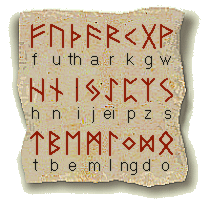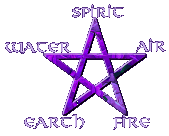
History of Runes

Runic symbols have been found carved on rocks dating from the Neolithic and Bronze Ages, (c. 8000 BC - 2000 BC). Continuing discoveries showed they had been carved by tribes in Northern Italy (Etruria); they were also present in Sweden, and among the Germanic people. Dr R. I. Page of Cambridge University (Reading the Past - runes 1987) notes that the runic forms were well established and gave the appearance of having been in use for some centuries before the time of the earliest written language inscriptions.
The runic characters, originally derived from the Roman alphabet, first appeared around 200 AD. They numbered 24, divided into three groups It was not until about AD200, when the Runemal (i.e. the art of runic interpretation) was wide-spread in Northern Europe that the runic alphabet emerged in the Germanic lands. This alphabet became known as the Futhark or Futhork, after the names of the first 6 Runes (Fehu, Uruz, Thurisaz, Ansuz, Raido, Kauno) and it is these 24 symbols - plus the blank Rune representing Destiny - called Aettas, which corresponds closely to the phonetic sounds of the Roman alphabet.
Although runic carvings were found throughout western Europe, but the greatest concentration was in England where the alphabet was increased to thirty-three characters from its original twenty-four. In Scandinavia it was reduced to sixteen. In Britian the alphabet was called "futhorc" after its first letters F, U, TH, O, R, K. The runes coexisted for centuries along with Christian symbols such as the cross. One of the earliest historical references to them is in the 4th. century AD when the Gothic bishop Ulfilas in devising the Gothic alphabet borrowed the U and O from the runic alphabet. Recorded history abounds with examples of the runes endowed with secret or mystical power. The Greek historian Herodotus (484-424BC) records a form of Runecasting with sticks by Scythian tribesmen (a nomadic people of upper Asian origin who settled around the Black Sea about 700 BC) in the Caucasus region about 470BC. The ceremony was accompanied by much ritual and the use of soporific smoke. The Roman historian Cornelius Tacitus (58-120AD) records a Germanic tribal Runemal in some detail in Chapter 10 of his ethnographical work Germania from about 97AD when he was Consul to the region:
"To divination they pay much attention. Their method is a simple one: they cut a branch from a fruit-bearing tree and divide it into small pieces which they mark with certain distinctive signs and scatter at random onto a white cloth. Then the priest of the community (if it is done publicly) or the father of the family (if it is done privately) after invoking the gods and with eyes raised to heaven, picks up three pieces one at a time and interprets them in accordance with the signs previously marked on them." When the high chieftains and lawgivers of Anglo-Saxon England met in secret, their assemblies were known as The Runes: and a 4th Century translation of the Bible uses the word Runa for "mystery" or "secret proceedings". According to myth, the runes were created by the Norse god Odin (also Woden or Woten), the one-eyed chief of the gods, also the god of wisdom and war. Odin acquired the forbidden and mystical knowledge of the runes by impaling himself by his own spear to Yggdrasil, the World Tree, for nine days and nights. According to the Havamal, one of the poems in the Poetic Edda, in order to find the runes the god Odin had to hang from Yggdrasil (The World Tree) for nine days without food or water, pined to it by his own spear. There are obvious similarities here to the traditional imagery of the Hanged Man Tarot card, especially as, like the figure in the Rider-Waite deck for example, Odin hung upside down. This inversion is important because it implies a humility and a willingness to look at the world afresh. Odin's action can be seen as an extreme form of shamanistic ritual helping him to reach an altered state of consciousnes. For, on the 9th night as he lay between life and death, he first saw the runes.
"Down into the depths I gazed
Crying aloud I took up runes
Then finally I fell"
The reference to "depths" or "down" (translations vary) is not only to the roots of Yggdrasil but to Odin himself. This was a moment of self-realisation also - looking into his inner depths. This is supported by another line which speaks of this being a sacrifice of Odin to Odin. Having picked up the runes Odin is newly empowered and he is released from the tree and the state between life and death in which he was hovering. He thus falls back to the ground but with the runes in his hands. The Edda also mentions Bragi, master of the skalds (minstrels) and a great storyteller who reputedly had runes tattooed on his tongue - a reference to his magical gift as a raconteur.
The slightly later poem Erik the Red describes a Runemistress in full regalia. The traditional lore of Finland, as recorded in the Kalevala by Lönnrot in 1835, describes a confrontation of wizards.
Belief in runic power was strong among the German soldiers during World War I. This was because "secret chiefs" of the Germanen Order, a runic society founded in 1912, signed their names in runic characters. They sold amuletic bronze rune rings to solders for protection. A rune mania occurred throughout the country which included yodelling during yoga-like exercises to release the rune's mystical powers, and meditating over runes to cure illnesses.
Perhaps two runes were destroyed forever by the Nazis. These are the swastika, originally Mjoelhir, Thor's hammer and the symbol of the Earth Mother and the sun; and the sig or S rune, the trademark of Heinrich Himmler's "Schutzstaffel," or the SS. The Norse neo-Pagans tried to bring back the Swastika as a runic symbol without much success.
The ancient usage of the swastika not only as a symbol by Indo-European cultures dates back perhaps prior to 700 BC in Greece where it was painted on amphoreis and various ceramic artifacts, and even graves. Also it exists in many other cultures such as the Chinese and Native Americans.
Home
About Us
Tarot Readings
Psychic Readings
Runes Readings
Dreams
Numerology Readings
Free Reading
Our Services & Fees
Purchase
Email Order Form
Contact Us
Feedback Form
Guestbook

@Copyright White Feather 2006



